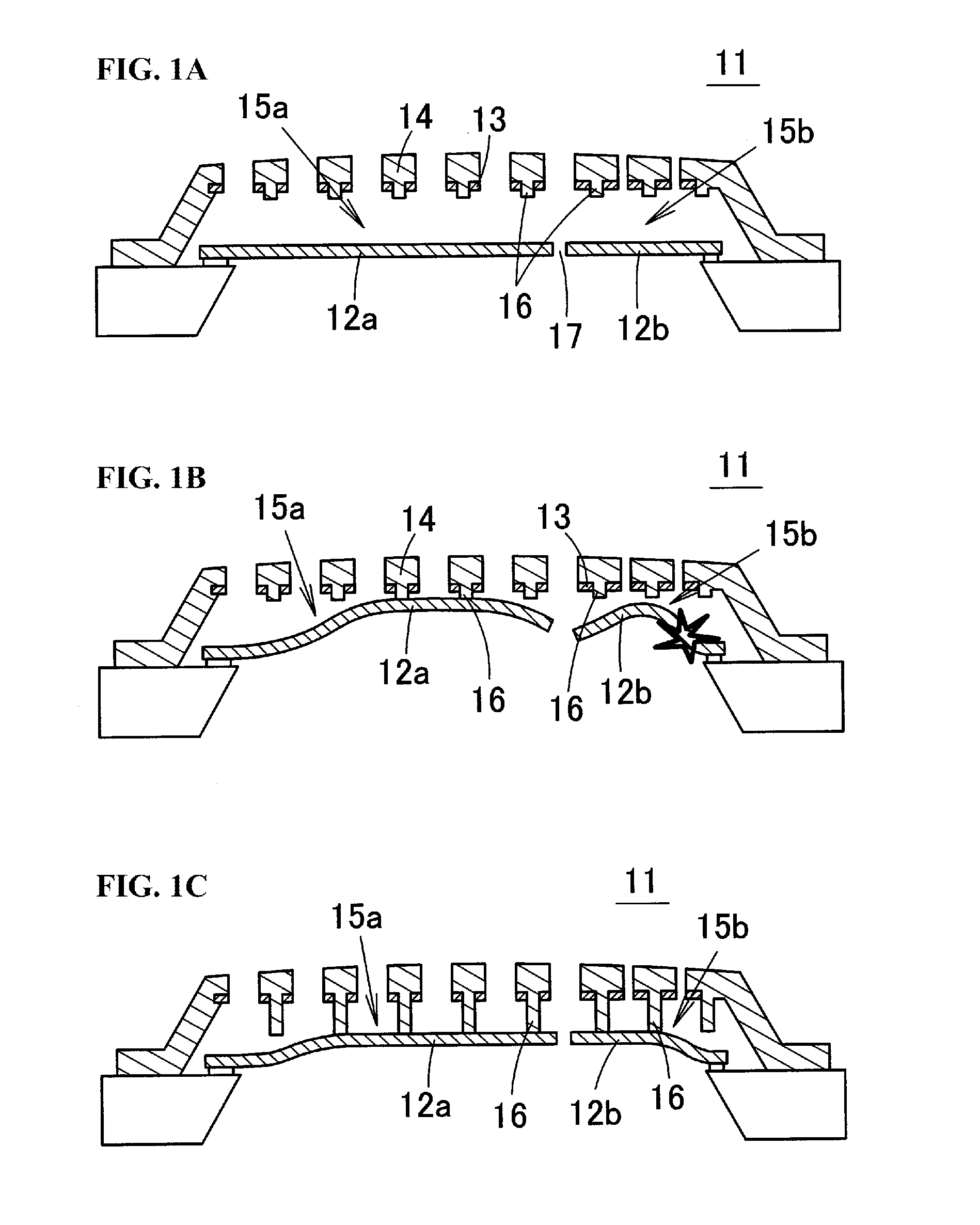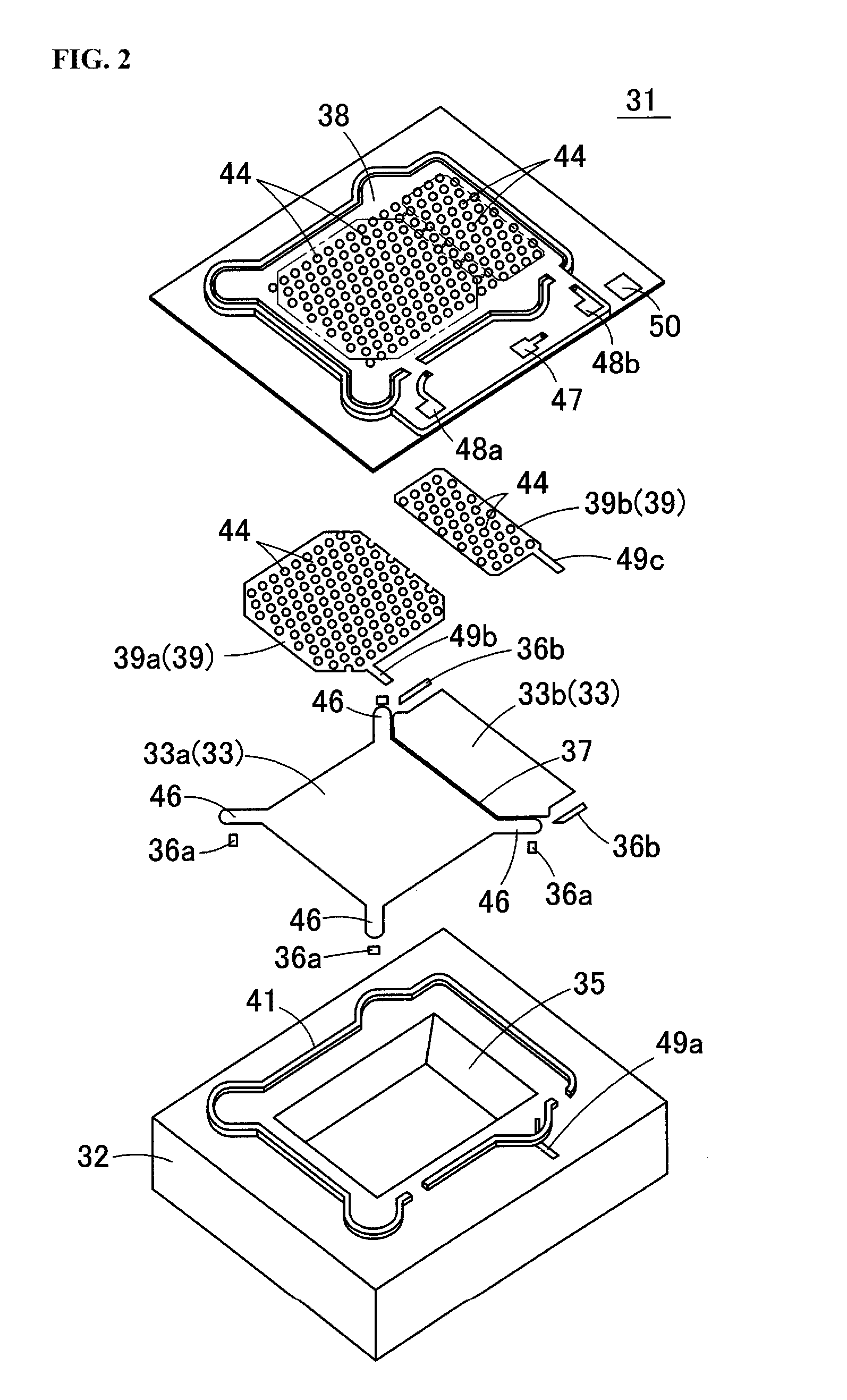Capacitance-type transducer
a capacitance-type transducer and capacitor technology, applied in the direction of semiconductor electrostatic transducers, transducer diaphragms, mouthpiece/microphone attachments, etc., can solve the problems of affecting the performance of the capacitance-type transducer, hindering the diaphragm, and unable to detect acoustic vibration by the acoustic sensor, so as to improve the damage resistance and prevent a large amount of stress. ,
- Summary
- Abstract
- Description
- Claims
- Application Information
AI Technical Summary
Benefits of technology
Problems solved by technology
Method used
Image
Examples
embodiment 1
Manufacturing Method of Embodiment 1
[0072]Next, a method for manufacturing the acoustic sensor 31 of Embodiment 1 will be described with reference to FIGS. 8A to 8D and FIGS. 9A to 9C. FIGS. 8A to 8D and FIGS. 9A to 9C all show enlargements of a portion of the acoustic sensor during respective manufacturing steps.
[0073]First, as shown in FIG. 8A, an oxide film 52 (SiO2) is deposited on the entirety of the upper surface of the substrate 32 (Si substrate). Next, as shown in FIG. 8B, a polysilicon film 53 is deposited on the oxide film 52, and the polysilicon film 53 is etched to form the diaphragms 33a and 33b on the upper surface of the oxide film 52. At this time, the first diaphragm 33a and the second diaphragm 33b are separated by the slit 37. Steps for forming and then removing the mask for etching will not be described here, and the same follows below.
[0074]As shown in FIG. 8C, a first sacrifice layer 54 made of a Si oxide film is deposited on the entirety of the upper surface o...
embodiment 2
[0083]FIG. 12 is a schematic cross-sectional diagram showing an acoustic sensor 71 according to Embodiment 2 of the present invention. In the acoustic sensor 71, the second acoustic sensing portion 43b is provided with stoppers 45b having a longer projection length than the stoppers 45a in the first acoustic sensing portion 43a, and more specifically, the second acoustic sensing portion 43b is provided with two types of stoppers 45b having different projection lengths, namely comparatively short stoppers 45b and comparatively long stoppers 45b. The comparatively short stoppers 45b are provided in the region that opposes the region of the second diaphragm 33b that undergoes large displacement, and the comparatively long stoppers 45b are provided in the region that opposes the region of the second diaphragm 33b that undergoes small displacement (e.g., the vicinity of the portion fixed by the anchor 36b).
[0084]FIG. 13B shows the case where stoppers 45b having a uniform length are provi...
embodiment 3
[0087]In an acoustic sensor 81 of Embodiment 3, the projection lengths of the stoppers 45a and 45b are set to change gradually. FIG. 14A is a schematic cross-sectional diagram of the acoustic sensor 81 of Embodiment 3, the cross-section being taken along line X-X in FIG. 15. FIG. 14B is a schematic cross-sectional diagram of the acoustic sensor 81 of Embodiment 3, the cross-section being taken along line Y-Y in FIG. 15. FIG. 15 shows displacement of the first diaphragm 33a and the second diaphragm 33b when pressure is applied to the two diaphragms 33a and 33b. In FIG. 15, regions with a higher dot density indicate larger displacement, and regions with a lower dot density indicate smaller displacement.
[0088]In the acoustic sensor 81 of Embodiment 3, the projection lengths of the stoppers 45a and 45b are set to change gradually such that the tips of the stoppers 45a and 45b follow the shape of the upper surfaces of the diaphragms 33a and 33b when undergoing deformation to the extent t...
PUM
 Login to View More
Login to View More Abstract
Description
Claims
Application Information
 Login to View More
Login to View More - R&D
- Intellectual Property
- Life Sciences
- Materials
- Tech Scout
- Unparalleled Data Quality
- Higher Quality Content
- 60% Fewer Hallucinations
Browse by: Latest US Patents, China's latest patents, Technical Efficacy Thesaurus, Application Domain, Technology Topic, Popular Technical Reports.
© 2025 PatSnap. All rights reserved.Legal|Privacy policy|Modern Slavery Act Transparency Statement|Sitemap|About US| Contact US: help@patsnap.com



